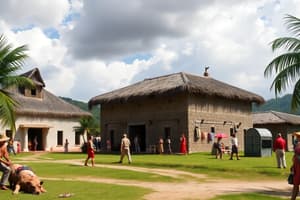Podcast
Questions and Answers
What was a significant characteristic of the New England Colonies?
What was a significant characteristic of the New England Colonies?
- Economy driven by mining and mineral resources
- Economy based on plantations and cash crops
- Prominent Puritan religious influence (correct)
- Diverse population with many languages spoken
What was the primary economic activity in the Southern Colonies?
What was the primary economic activity in the Southern Colonies?
- Commerce and trade with Native Americans
- Cotton and textile manufacturing
- Plantations growing cash crops (correct)
- Fishing and shipbuilding
What was the role of colonial assemblies in colonial government?
What was the role of colonial assemblies in colonial government?
- To serve as local governments for legislation (correct)
- To manage relations with Native Americans
- To conduct all military operations in the colonies
- To enforce British law universally
Which colonial power was primarily involved in the French and Indian War?
Which colonial power was primarily involved in the French and Indian War?
What was a major consequence of mercantilism on the colonies?
What was a major consequence of mercantilism on the colonies?
What was an important factor in the social structure of colonial America?
What was an important factor in the social structure of colonial America?
Which of the following best describes the Middle Colonies?
Which of the following best describes the Middle Colonies?
What was a common aspect of education in Colonial America?
What was a common aspect of education in Colonial America?
Flashcards are hidden until you start studying
Study Notes
Colonial America
-
Time Period: Late 16th century to 1776
-
Key Colonial Powers:
- England
- France
- Spain
- Netherlands
-
Major Colonies:
- New England Colonies: Massachusetts, New Hampshire, Rhode Island, Connecticut
- Economy based on fishing, shipbuilding, and trade.
- Puritan religious influence.
- Middle Colonies: New York, Pennsylvania, New Jersey, Delaware
- Diverse population; agriculture and commerce flourished.
- Known for religious tolerance and cultural diversity.
- Southern Colonies: Virginia, Maryland, North Carolina, South Carolina, Georgia
- Economy centered on plantations and cash crops (tobacco, rice, indigo).
- Heavily reliant on enslaved African labor.
- New England Colonies: Massachusetts, New Hampshire, Rhode Island, Connecticut
-
Colonial Life:
- Social Structure: Hierarchical society with wealthy landowners, middle-class artisans, and indentured servants/slaves.
- Religion: Varied by region; prominent groups included Puritans, Quakers, Anglicans, and Catholics.
- Education: Generally limited; more established in New England; focused on religious teachings.
-
Colonial Government:
- Self-governing systems established; varied by colony.
- Influence of British common law and local governance.
- Colonial assemblies played a significant role in legislation.
-
Conflicts and Relations:
- Native American Relations: Initially trade partnerships turned into conflict; significant wars included King Philip's War and the French and Indian War.
- Colonial Wars: French and Indian War (1754-1763) pitted British colonists against French and Indigenous allies.
-
Economic Factors:
- Mercantilism: Colonies existed to benefit the mother country.
- Triangular Trade: Transatlantic trade system involving slaves, goods, and raw materials.
-
Cultural Development:
- Growth of regional identities and distinct cultural practices.
- Emergence of early American literature and philosophy.
-
Path to Independence:
- Increasing British taxation and restrictions (e.g., Stamp Act, Tea Act).
- Colonial resistance movements (e.g., Boston Tea Party, First Continental Congress).
- Development of revolutionary sentiment leading to the American Revolution.
Time Period and Colonial Powers
- Colonial America spanned from the late 16th century until 1776.
- Major colonial powers included England, France, Spain, and the Netherlands.
Major Colonies
-
New England Colonies:
- Included Massachusetts, New Hampshire, Rhode Island, and Connecticut.
- Economy was focused on fishing, shipbuilding, and trade.
- Strong influence of Puritan religious values.
-
Middle Colonies:
- Comprised New York, Pennsylvania, New Jersey, and Delaware.
- Featured a diverse population with thriving agriculture and commerce.
- Notable for religious tolerance and cultural diversity.
-
Southern Colonies:
- Consisted of Virginia, Maryland, North Carolina, South Carolina, and Georgia.
- Economy relied heavily on plantations producing cash crops like tobacco, rice, and indigo.
- Heavy dependence on enslaved African labor to support the economy.
Colonial Life
-
Social Structure:
- Society was hierarchical, with wealthy landowners, artisans, and a significant number of indentured servants and enslaved individuals.
-
Religion:
- Varied by region, with major groups including Puritans, Quakers, Anglicans, and Catholics.
-
Education:
- Generally limited, though more established in New England; education often focused on religious teachings.
Colonial Government
- Each colony had self-governing systems that varied in their structures.
- British common law heavily influenced colonial governance, with local assemblies playing crucial legislative roles.
Conflicts and Relations
-
Native American Relations:
- Initial trade partnerships often devolved into conflicts, with significant confrontations like King Philip's War and the French and Indian War.
-
Colonial Wars:
- The French and Indian War (1754-1763) involved British colonists, the French, and Indigenous allies in a struggle for territorial dominance.
Economic Factors
- The principle of mercantilism suggested that colonies existed primarily for the economic benefit of the mother country.
- The Triangular Trade involved transatlantic trade of slaves, goods, and raw materials, connecting Africa, the Americas, and Europe.
Cultural Development
- Regional identities and distinct cultural practices began to emerge across the colonies.
- Early American literature and philosophy saw initial growth, reflecting colonial experiences and values.
Path to Independence
- Growing dissatisfaction stemmed from increasing British taxation and restrictions, exemplified by the Stamp Act and Tea Act.
- Colonial resistance was highlighted by key events like the Boston Tea Party and the assembly of the First Continental Congress.
- Rising revolutionary sentiment laid the groundwork for the onset of the American Revolution.
Studying That Suits You
Use AI to generate personalized quizzes and flashcards to suit your learning preferences.




